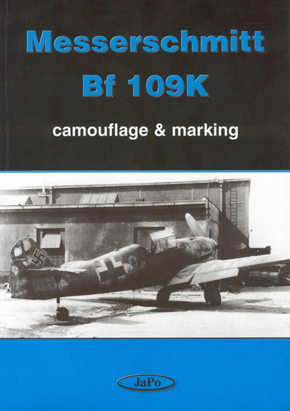JaPo | Messerschmitt Bf 109K Camouflage & Marking
Reviewed by Mark Proulx

8"x12"
132 Pages
Approx. 127 Photos
Soft Cover
This is a review of the JaPo book detailing the camouflage and markings of the Bf 109K, the last in the line of fighters. I am writing this review in part due to the recent release by Hasegawa of the Bf 109K-4 in 1/32nd scale and subsequent decals from Eagle Editions.
This book is a sequel to the Bf 109K also from JaPo and reviewed by Tony Oliver. The authors are identified as Ing. Tomas Poruba and Kees Mol. No ISBN number appears with the book.
The majority of the text in the book is English. It is lavishly illustrated with side profiles, sixteen in color. An example is the side profile of White 5 that accompanies this review. There are also numerous black and white drawings that detail the progression of the various camouflage schemes by werk number series. This includes side, upper and lower views explained with detailed captions. Given the rarity of Bf 109K photos it is incredible that the authors have amassed this array of mostly unpublished images, some in color. This is made possible by contributions from such notable authors as Berd Barbas, Dr Jochen Prien and Michael Ullmann, to name a few.
The book begins by detailing the standards and provisions for aircraft finishing as outlined in L.DV. 521 in its three parts. This detailed explanation includes color photos of Bf 109K parts still in existence and scans of Bf 109K camouflaging from the aircraft manual. The authors subsequently identify the development of the camouflage patterns as applied to the aircraft. As with many late war German aircraft, there were exceptions to the rule and the most frequent ones are also discussed.
Poruba and Mol then proceed to identify the operational markings of the 109K. This includes book sections about heraldry, tactical and unit markings. Brief notes are also available detailing the service in Italian ANR units, however there are no known photos to refer to at this time. Complete stencil details are included showing the proper location and color for each placard. Each stencil is enlarged and easy to read.

A complete listing of confirmed data is also included for each known Bf 109K. This includes information such as werk number, loss details, individual aircraft number and unit assignment as examples. This is a very welcome addition to the book given the chaos faced by the Luftwaffe late in the war and the lack of available information. This list covers an amazing 13 pages and is followed by a number of color chips. Samples are also included of possible colors for use when interpreting orthochromatic or panchromatic black and white film. This is a source of constant debate among modelers and historians and is likely the reason for the fascination in these late war aircraft. I am sure many will appreciate these charts.
I have been fortunate enough to read a number of books on late war German aircraft. In my opinion, this book is among the best I have ever read on the subject though the title limits the scope to the 109K. The effort is even more impressive given the gaps in information that still exists today. An additional vote of confidence can also be found from Eagle Editions as this book was used as a reference for many of the schemes in EC#74 and EC#75. Any modeler with an interest in the Bf 109K or late war German aircraft should have this book in their reference library. Authors Poruba and Mol are to be commended for their efforts and I strongly recommend this title.
© Mark Proulx 2004
This review was published on Saturday, July 02 2011; Last modified on Wednesday, May 18 2016
